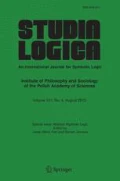Abstract
Inspired by recent work on proof theory for modal logic, this paper develops a cut-free labelled sequent calculus obtained by imitating Herzberger’s limit rule for revision sequences as a clause in a possible world semantics. With the help of two completeness theorems, one between the labelled sequent calculus and the corresponding possible world semantics, and one between the axiomatic theory of truth PosFS and a neighbourhood semantics, together with the proof of the equivalence between the two semantics, we show that the theory of truth obtained with the labelled sequent calculus based on Herzberger’s limit rule is equivalent to PosFS.
Similar content being viewed by others
References
Baaz, M., C. G. Fermüller, G. Salzer, and R. Zach, Labeled calculi and finite-valued logics, Studia Logica 61(1): 7–33, 1998.
Belnap, N. D., Gupta’s rule of revision theory of truth, Journal of Philosophical Logic 11(1): 103–116, 1982.
Friedman, H., and M. Sheard, An axiomatic approach to self-referential truth, Annals of Pure and Applied Logic 33(1): 1–21, 1987.
Gentzen, G., Untersuchungen über das logische Schliessen i, ii’ Mathematische Zeitschrift 39: 176–210, 405–431, 1934.
Girlando, M., S. Negri, N. Olivetti, and V. Risch, Conditional beliefs: From neighbourhood semantics to sequent calculus, Review of Symbolic Logic 11(4): 736–779, 2018.
Gupta, A., Truth and paradox, Journal of Philosophical Logic 11(1): 1–60, 1982.
Gupta, A., and N. Belnap, The Revision Theory of Truth. MIT Press, 1993.
Halbach, V., A system of complete and consistent truth, Notre Dame Journal of Formal Logic 35(1): 311–327, 1994.
Herzberger, H. G., Notes on naive semantics, Journal of Philosophical Logic 11(1): 61–102, 1982.
Horsten, L., G. E. Leigh, H. Leitgeb, and P. Welch, Revision revisited, Review of Symbolic Logic 5(4): 642–664, 2012.
Kremer, M., Kripke and the logic of truth, Journal of Philosophical Logic 17(3): 225–278, 1988.
McGee, V., How truthlike can a predicate be? a negative result, Journal of Philosophical Logic 14(4): 399–410, 1985.
Negri, S., Proof analysis in modal logic, Journal of Philosophical Logic 34: 507–544, 2005.
Negri, S., and G. Sbardolini, Proof analysis for lewis counterfactuals, The Review of Symbolic Logic 9: 44–75, 2016.
Negri, S., and Jan von Plato, Cut elimination in the presence of axioms, Bulletin of Symbolic Logic 4: 418–435, 1998.
Negri, S., and Jan von Plato, Structural Proof Theory. Cambridge University Press, 2001.
Negri, S., and Jan von Plato, Proof Analysis: A Contribution to Hilbert’s Last Problem. Cambridge University Press, 2011.
Pacuit, E., Neighborhood Semantics for Modal Logic. MIT Press, 2017.
Ripley, D., Conservatively extending classical logic with transparent truth, Review of Symbolic Logic 5(2): 354–378, 2012.
Schröder-Heister, P., Restricting initial sequents: The trade-offs between identity, contraction and cut, in R. Kahle, T. Strahm, and T. Studer, (eds.), Advances in Proof Theory,Progress in Computer Science and Applied Logic 28, Birkhäuser, 2016, pp. 339–351.
Troelstra, A. S., and H. Schwichtenberg, Basic Proof Theory. Cambridge University Press, 2000.
Acknowledgements
For discussions and comments on the material that resulted in this paper, I would like to thank Casper Storm Hansen, Fausto Barbero, Jan von Plato, Maria Hämeen-Anttila, Marianna Girlando, Ole Hjortland, Sara Negri and Tuukka Tanninen. I would also like to thank the anonymous referees for their many helpful suggestions. The research for this paper was supported by a FRIPRO Mobility Fellowship for the project Expressing Validity by Revision: Logical and Philosophical Aspects from the Research Council of Norway (project no 262837/F10, co-funded by the European Union’s Seventh Framework Programme for research, technological development and demonstration under Marie Curie grant agreement no 608695).
Author information
Authors and Affiliations
Corresponding author
Additional information
Publisher's Note
Springer Nature remains neutral with regard to jurisdictional claims in published maps and institutional affiliations.
Presented by Heinrich Wansing
Rights and permissions
About this article
Cite this article
Fjellstad, A. Herzberger’s Limit Rule with Labelled Sequent Calculus. Stud Logica 108, 815–855 (2020). https://doi.org/10.1007/s11225-019-09878-x
Received:
Published:
Issue Date:
DOI: https://doi.org/10.1007/s11225-019-09878-x




